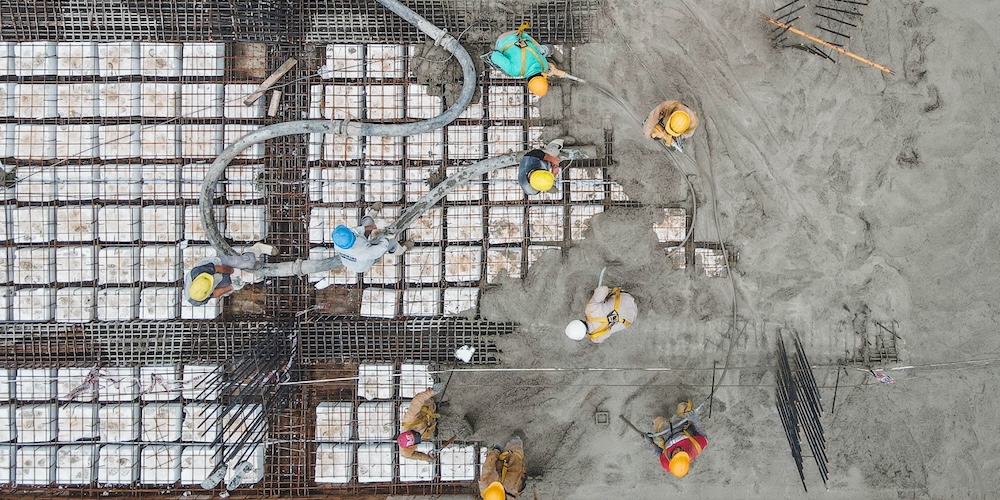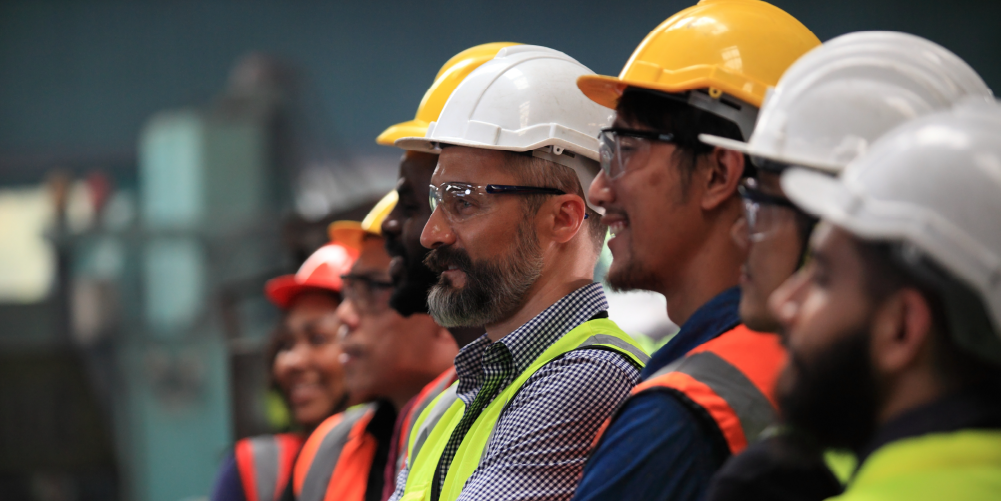— 7 min read
6 Phases of Construction Project Management Explained
Last Updated Aug 13, 2024
Last Updated Aug 13, 2024

Construction projects are like no other. Each one is unique, having different participants, variable conditions, and one-off requirements. But across them all, you’ll find construction project phases are strikingly similar.
Broadly, the phases of a construction project move on a linear timeline. Let's take a look at the six main phases of construction project management common across most project life cycles.
Table of contents
1. Project design
The construction phases of a project’s life cycle begin with its design. Here, the owner builds the case for constructing the project. Sometimes, after all is considered, the owner might find the project is not workable.
Making a business case
Whether it’s a high-rise office building or a low-rise multifamily housing project, owners must always satisfy a business case for the project. In this part of the design phase, the owner envisions the property’s use and the financial incentives for that use.
Conducting a feasibility study
The feasibility study either convinces the owner the project is possible, flags it as needing adjustments, or shows it as a no-go. In this part of the design phase, the owner considers variables ranging from land use to construction costs while fine-tuning the best use. If the project is deemed possible, then it moves into the next phase.
Defining the project scope
In the scoping phase, the owner works closely with architects, engineers, and sometimes even contractors to decide the project size and features. The goal is to match the finished project to its immediate use after construction and to accommodate additional uses as the project ages. At this phase, the design team renders all the drawings and specifications needed to build the project.
2. Project procurement
With the project plans completed, the owner moves the project to the next phase. In this second of the construction project phases, the goal is to assemble the team that will do the construction.
Selecting the delivery method
A prime consideration for any project is the delivery method. Until the last decade, owners almost always chose the design-bid-build delivery method. Today, more and more projects are opening up to design-build and integrated project delivery. These collaborative methods lead to lower costs and better project outcomes. The owner chooses the delivery method that will best fulfill the project’s goals.
Learn more: 6 Construction Project Delivery Methods Compared
Selecting participants
The owner often selects project participants by inviting contractors or construction managers to bid on the project. Sometimes the owner may already have a working relationship with particular contractors, like is often the case with corporate owners, so they will invite them to the project.
Sometimes contractors submit hard bids to win the project, while other times, the contractors and owners work together to design and price the project. In all cases, the owner is trying to achieve the best value for the money while rendering the project as close to their original intent as possible.
Awarding contracts
Awarding contracts is the last part of this construction project phase. The owner must weigh multiple factors in selecting the builder. Price is a top consideration, but the builder’s track record, its ability to insure and bond for the project, and the builders’ experience with similar projects all figure into the decision.
Stay updated on what’s happening in construction.
Subscribe to Blueprint, Procore’s free construction newsletter, to get content from industry experts delivered straight to your inbox.

3. Project preconstruction
With contracts signed, the general contractor or construction manager gets to work on all details needed to start construction. First, they must round out the required help. Most GCs and CMs will come to the job with a group of subcontractors already known to them. However, specialty aspects of the project often require them to locate and partner with specialists. The GCs and CMs spend much time at this phase bringing people, materials, and equipment together, and planning everything out.
Obtaining permits
Few localities exist where you don’t need permits for construction. Contractors get to work pulling permits for everything from utility work to building code requirements.
Site surveying
Contractors consult site surveys to confirm their understanding of what already exists on the construction site. These surveys often find conditions that weren’t included in the contract documents. This is the first opportunity contractors have to record and begin managing the inevitable surprises inherent in any construction project.
Creating a risk management plan
Almost all contracts today require the contractor to have a formal risk management plan. The contractor must assess all the project risks and make plans for eliminating them, controlling them, or insuring against them. Besides protecting the owner, these plans help the contractor foresee and avoid surprise costs arising from risks.
Setting up a safety plan
While safety is also a risk item on construction projects, contractors usually deal with it separately because safety risks are so far-reaching. They often involve life and death, so contractors want to make them a top priority.
Creating work breakdown structures
Contractors break construction projects into activities and tasks. Activities are the units of construction, like pouring the foundation. Tasks are the steps needed to complete those activities. A work breakdown structure lists all the tasks needed for each activity. Many construction projects have thousands of activities, so the WBS creates a clear roadmap from project start to project end.
Designing the project schedule
It’s the project managers' and schedulers’ jobs to turn the WBS into a schedule that work crews can follow. The schedule reflects the longest time to project completion. It includes milestones so managers can assess how well the project is hitting its schedule.
Setting up a communications plan
Construction contracts often require contractors to have a communications plan that meshes with the project comms plan. Here, the contractor specifies how required and time-sensitive communications should take place. They also include accountability controls so parties to the contract know their responsibilities for communicating project information.
4. Project execution
The fourth phase is where all the earlier work gets validated, or not.
Preconstruction meetings
Contractors kick off the project with preconstruction meetings. During these meetings, all the parties review the project so they understand their roles and how they fit into the wider project.
Procuring resources
GCs and specialty contractors buy and order all the materials, parts, and equipment needed for o their portions of the work. They also set up their work crews and labor management plans.
Starting activities
This part of the project execution phase is where the physical work begins. Contractors take virtual, or 2D plans, and turn them into 3D.
5. Project control
Without controls, construction projects can get gravely sidetracked. There are too many moving parts and too many variables to operate without controls.
Tracking work
Once construction is underway, this is the most important of the construction project management phases. Without adequate tracking, it’s very easy to lose control of the activities. This is where many PMs rely on web-based construction management software because it’s always on and has the most recent project information.
Tracking activities against time objectives
Each construction schedule sets a time limit for each activity. Getting done early can sometimes throw a timeline off as much as getting done late, so project managers want to see how closely crews are hitting the scheduled times.
Tracking quality of activities and tasks
Rework and change orders fill the day without quality checks. Each task must meet the assigned quality. Otherwise, tasks coming after can also miss the quality mark.
Learn more: The Importance of Minimizing Construction Rework
Adjusting the schedule
As project managers pour over the times and quality aspects of projects, they sometimes must adjust the schedule to reflect the project’s latest trajectory.
Tracking the budget
All parties working on the project have their own budgets to track. However, the GC or CM must also track the overall project budget. If the budget looks like it might start running in the red, the GC or CM must find the reason, and quickly.
6. Project closure
Delivering the punch list
The punch list shows all the problems with the job that must get corrected before closeout. Crews work on the portions of the punch list that match their specialties.
Commissioning
For projects involving buildings, this closeout aspect certifies that all the equipment and systems work properly.
Budget closeout
Closing out the budget means that everybody can get paid the final monies owed to them. If the owner and GC have withheld retainage, then this lump sum also comes due.
Framework for project planning
It’s no coincidence the early construction project phases are more mired in detail than the later ones. Wise owners and contractors have figured out that an ounce of planning can cancel out many pounds of rework and mistakes. The construction project phases provide the framework for well-planned projects.
Was this article helpful?
Thank you for your submission.
94%
6%
You voted that this article was . Was this a mistake? If so, change your vote here.
Scroll less, learn more about construction.
Subscribe to The Blueprint, Procore’s construction newsletter, to get content from industry experts delivered straight to your inbox.
By clicking this button, you agree to our Privacy Notice and Terms of Service.
Categories:
Tags:
Written by
Jonny Finity
29 articles
Jonny Finity creates and manages educational content at Procore. In past roles, he worked for residential developers in Virginia and a commercial general contractor in Bar Harbor, Maine. Jonny holds a BBA in Financial Economics from James Madison University. After college, he spent two and a half years as a Peace Corps Volunteer in Kenya. He lives in New Orleans.
View profileExplore more helpful resources

Construction Manager vs. Project Manager: Comparing Leadership Roles
Skillful oversight of construction projects allows companies to deliver to owners on time and within budget. Construction managers (CMs) and project managers (PMs) provide the necessary supervision to keep projects...

Mastering Construction Resource Management: Strategies for Success
Completing construction projects successfully requires the careful management of various resources: labor, materials, equipment, money, time and information. Since these resources are finite, allocating them wisely is crucial for minimizing...

Managing Construction Projects in Different States: A Contractor’s Guide to Working Across State Lines
For many general contractors, taking on work in a new state or region can offer transformative opportunities for building a thriving business and a respected reputation. But managing projects is...

Construction Teamwork: Build a Solid Foundation With the Right Team
Construction is an industry of collaboration — no one person completes any job on their own. It could easily be argued that the most important skill for anyone in this...

